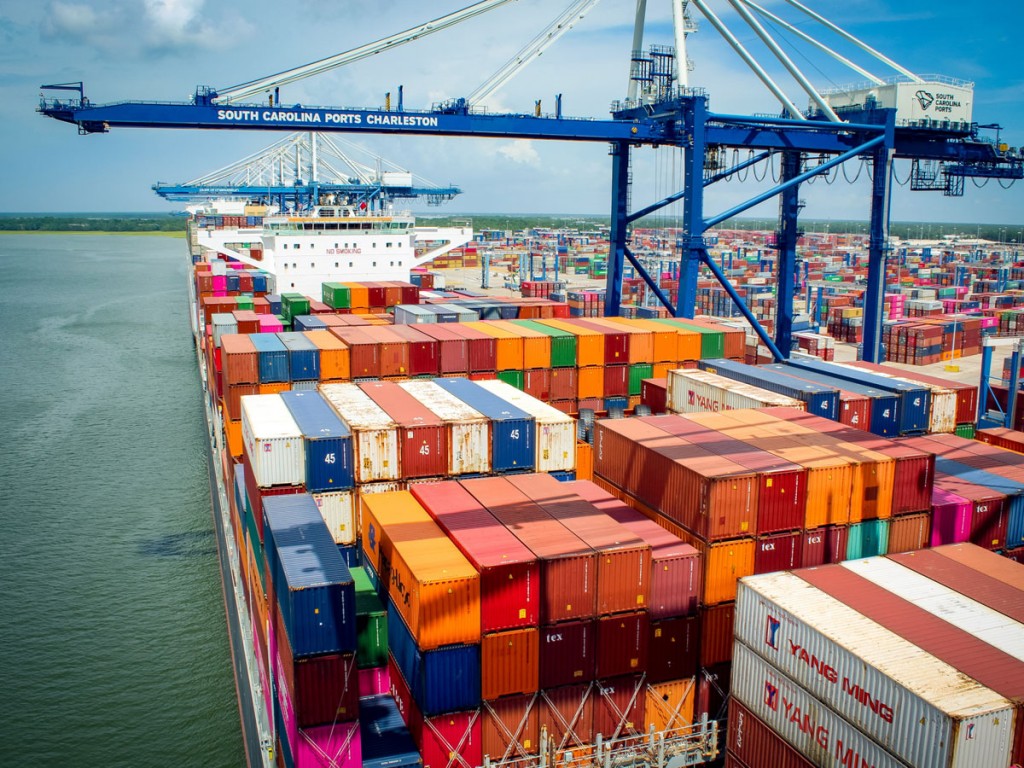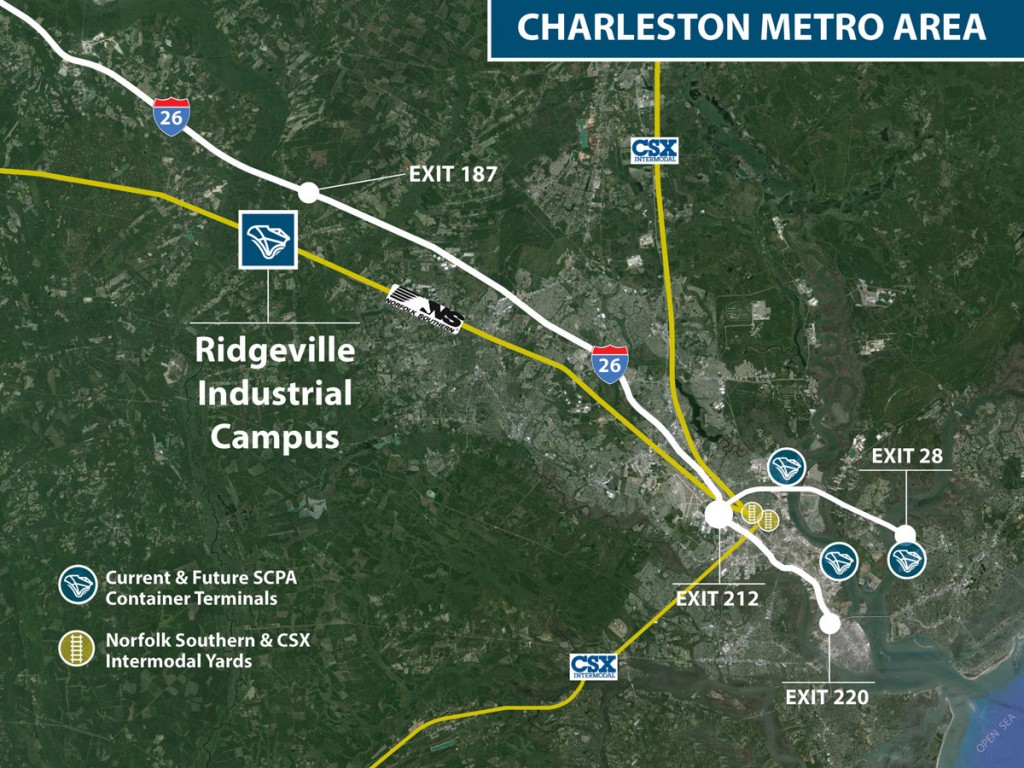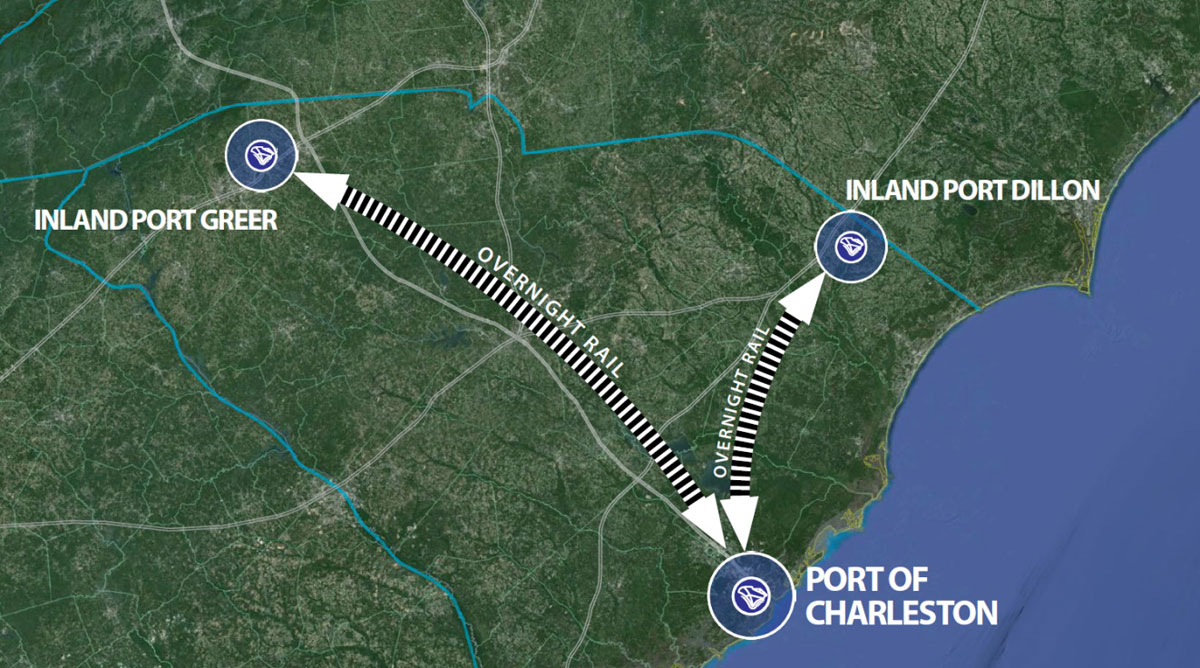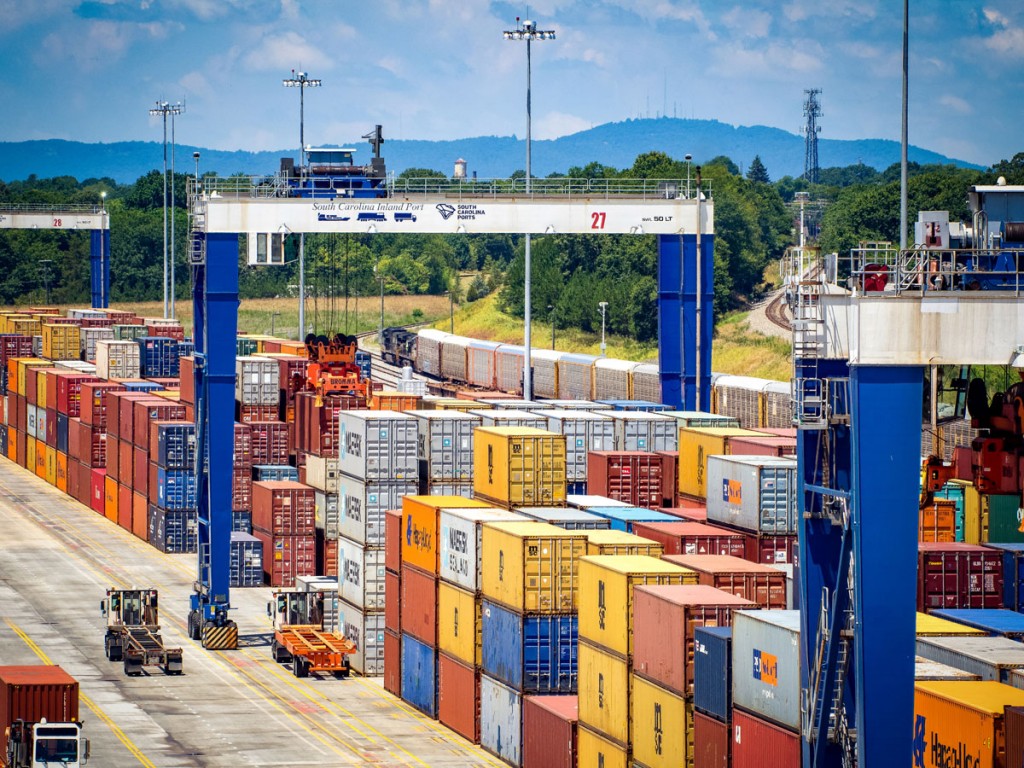South Carolina booming as distribution hub as SC Ports grows inland intermodal capabilities
Soon to boast the U.S. East Coast’s deepest harbor and with expanding capabilities for handling megacontainerships, South Carolina is enjoying a boom as a preferred distribution hub, with Walmart the latest to announce plans for a commerce park about 30 miles from Port of Charleston docks.
The South Carolina Ports Authority’s Ridgeville Commerce Park, in Charleston suburban Dorchester County, along with a pair of thriving facilities farther inland, are critical rail-served links efficiently moving retail goods and other containerized cargo to and from Charleston marine terminals.
With a 52-foot-deep harbor and the first phase of the Hugh K. Leatherman Terminal opening in early 2021, augmented by a significantly enhanced Wando Welch Terminal, the Port of Charleston’s water infrastructure looks to be second to none. Inland connections are to be further bolstered when an intermodal container transfer facility – to be served by both Norfolk Southern and CSX – is in place near the new Leatherman Terminal.

SC Ports extending abilities
Ridgeville Commerce Park, Inland Port Greer and Inland Port Dillon extend the abilities of SC Ports in serving the needs of beneficial cargo owners – to soon include Bentonville, Arkansas-based Walmart, the world’s largest retailer and the No. 1 importer into the United States.
In July, Walmart announced plans to build a $220 million, 3-million-square-foot distribution center at Ridgeville Commerce Park, culminating nearly four years of discussions involving not just Walmart and SC Ports but also county, regional and state development officials.
Walmart’s executive vice president of supply chain, Greg Smith, put it this way: “At a time when job creation is so vital, and – more than ever – our customers are relying on Walmart for the essentials they need during this unprecedented time, we are excited about the impact this new facility will have on the regional economy and how it will help us better serve customers across the Southeast.”

Walmart delivering 1,000 jobs
Walmart’s newest direct import distribution hub, which is expected to take about 14 months to build following March 2021 groundbreaking, is to supply several regional distribution centers supporting more than 850 Walmart and Sam’s Club stores throughout the Carolinas and beyond, plus e-commerce customers. More than 1,000 local full-time jobs are being created.
Jim Newsome, president and chief executive officer of the South Carolina Ports Authority, enthused, “Walmart represents the cutting edge of supply chain management sophistication and expectations.
“Having this world-class company choose our market for their distribution center is the ultimate vote of confidence in SC Ports and in South Carolina,” Newsome continued. “Walmart’s investment will create jobs for South Carolinians and boost cargo volumes at the Port of Charleston. We are experts at moving goods just-in-time for global companies. We are thrilled to partner with Walmart to further their growth and impact for years to come.”

Retail bringing diversification
Enhanced capabilities for distribution for retail customers are crucial to the sustained success of SC Ports, according to Newsome.
“To continue to grow, we knew we had to diversify our cargo base, including focusing on retail distribution,” Newsome said.
While megaretailer Walmart is the first company to commit to a Ridgeville Commerce Park facility, it is expected to be joined by numerous other firms in building distribution hubs on available sites at the port-owned commerce park, which is near the interchange of north-south Interstate 95 and east-west I-26 and just up Norfolk Southern Railway tracks from Port of Charleston marine terminals. A rail shuttle is part of eventual, future plans.
Federal funds giving boost
Federal officials also are sold on the Ridgeville Commerce Park and the role it bodes to play in retail supply chains – so much so that the U.S. Department of Transportation announced Sept. 16 that it has awarded SC Ports a $21.68 million Better Utilizing Investment to Leverage Development (BUILD) grant to be used for improvements on and near the commerce park.
On-site improvements backed by the federal grant include a 2-mile industrial access road, as well as a 20-acre truck chassis and empty container storage yard. Off-site improvements include widening S.C. Highway 27 to provide better access and traffic fluidity between the project site and Interstate 26.
Noting that SC Ports foresightedly bought the 1,000-acre Ridgeville site from WestRock in 2018, for a very reasonable $16 million investment, Newsome said, “That really gave us the footprint that we could turn around and offer to Walmart for this facility.”
Walmart is also served by a TradePort Logistics transload facility at SC Ports’ Wando Welch Terminal.
Port volumes to rise 5 percent
Walmart’s operations are projected to increase the Port of Charleston’s annual containerized cargo volume by about 5 percent.
To balance the heightened import business, SC Ports is looking to plastic resins and other transload opportunities to add to export volumes. Four local resin-packaging operations – Frontier Logistics, A&R Logistics, A&R Bulk-Pak and Mid-States Packaging – will fill a combined 75,000 export containers a year, according to Newsome.
SC Ports also is developing additional export business, including transloading of agricultural goods and forest products, “so that container lines don’t have to ship empty containers back,” he said.

Inland ports flourishing
SC Ports’ inland port facilities are vital to moving goods to and from Charleston as well, according to Newsome, who commented, “We’ve believed in expanding the port-type infrastructure to the interior of the state.
“Greer has been a rousing success,” he said, citing 150,000 annual rail lifts now taking place at SC Ports’ Inland Port Greer, which opened in 2013 about 220 miles northwest of Port of Charleston docks via overnight rail through Norfolk Southern. In the Greenville-Spartanburg metropolitan area, the Greer site is just off I-85 between Atlanta and Charlotte.
BMW, with a major automotive plant in Greer, accounts for about half of the Greer rail lifts, Newsome said, while recent additions in Upstate South Carolina include East Coast distribution hubs for tiremaker Michelin and First Solar Inc., the nation’s largest solar module manufacturer.
First Solar is among companies benefiting from the Port of Charleston’s access to such global markets as Vietnam, where First Solar has factories, and its overnight rail link to the Port of Charleston.
Michelin recently decided to move finished tires through Inland Port Greer for its nearby 3-million-square-foot distribution center. This builds off Michelin’s existing supply chain partnership with SC Ports; Michelin began moving raw materials through Inland Port Greer in 2015.

‘Innovative, creative’ facility
“It’s a really, really innovative and creative and successful inland port,” Newsome said of Inland Port Greer. More than 90 million consumers live within a 500-mile radius – or one-day truck trip – of Inland Port Greer.
SC Ports’ second remote hub, Inland Port Dillon, opened in 2018 just off I-95 near the South Carolina-North Carolina line, about 130 miles north of Charleston. The Dillon facility, served by CSX rail, has Harbor Freight Tools as its anchor client and is seeing about 35,000 container moves a year.
“We believe in expanding rail,” Newsome said. “It’s one of our initiatives, because rail expands the reach of a port, and that’s critical to support our growth.”

